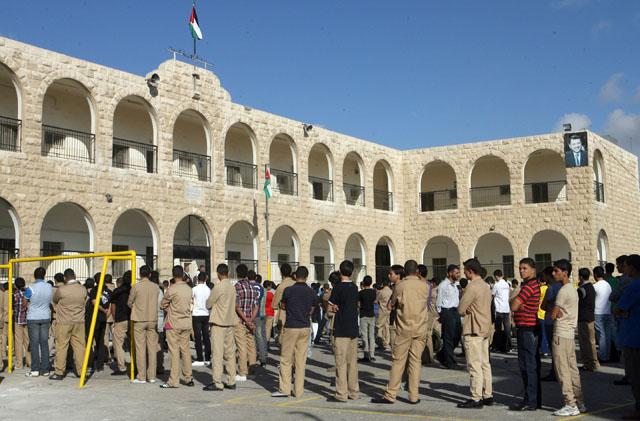You are here
Citizens lament waves of ‘promised improvements that never came’ to public schools
By Maram Kayed - Oct 27,2018 - Last updated at Oct 27,2018

Parents of Al Ruba Primary Schoolin Dhleel in Zarqa protest the bad conditions of the public school in September (Photo courtesy of Kareemeh Judeh)
AMMAN — “The building could collapse on students’ heads at any moment,” said Mahmoud Balasmeh, referring to the dilapidated buildings of Al Ruba Primary School in Zarqa, which were officially labelled over two years ago as “unfit for human habitation” by the Ministry of Education.
Only days ago, the first, second and third grades were relocated to a different building, also rented as a partial solution, one parent told The Jordan Times on Saturday.
Balasmeh, being the head of the Educational Development Board in Dhleel, noted that the school saw parts of a small room collapse on a teacher's head just last month, weeks after Minister of Education Azmi Mahafzah, promised parents in the area to move the students to “a more appropriate building”.
Al Ruba Primary School and its ramshackle buildings are one of several schools outside Amman that face threats of collapse, sanitation problems and a high percentage of students who do not pass the national Tawjeehi exam.
These schools have one thing in common, and that is — as parents, teachers and educational figures have noted — that they “were promised improvements that never came to life by the last three ministers of education”, as put by Balasmeh.
The Jordan Times spoke with teachers and parents from the north, middle and south of Jordan, who have urged the Ministry of Education to “expedite burecracratical procedures and fulfill their promises”, as Balasmeh noted.
Zarqa
The two-shift Al Ruba Primary School, which is standing on its last legs, is the educational nest of over 900 children in the eastern desert region.
Kareemeh Judeh, a parent of three girls who attend the school, said: “There are four children sitting in each desk. Is that a comfortable learning environment?”
She noted that the children fit in the desk because many of them suffer from malnutrition and thus have tiny figures. “This area is so poor that many children cannot afford lunch, so an NGO has taken the responsibility of packing lunches for the children and it has them [the lunches] ready by the break,” she told The Jordan Times.
Other than the over-crowded classrooms and poor economic background of students, the school’s issues are further compounded by its lack of proper facilities, such as the absence of a computer lab, a workshop and proper bathrooms.
“My daughter now has an inflammation of her urinary tract because I’ve warned her not to use the bathroom at school. I know it’s unhealthy, but 900 students share one bathroom, and with only one janitor for the whole premise; it’s not clean,” said Um Musab, another parent.
A teacher at the school, who preferred to remain anonymous and has taught there for over 13 years, said: “Just last week, part of the first grade corridor’s ceiling fell. If that had happened while the children were there, the teacher on call would be the one to blame for the injuries, not the ministry.”
She also complained of “not being able to give primary school children the attention and care they need, as having around 40 or 50 students to look after leaves the teacher with less than a minute for each child”.
When the ministry suggested at the beginning of this school year to transform the school into a two-shift system so that the facilities are not put under tremendous pressure, parents protested against the suggestion, saying that “the area is very remote, and wild dogs that roam the neighborhood at night are a threat to our little children”.
Parents also said that they afford fares for a bus to transport their children. In protests that took place in September, parents held signs that read: “Where are your promises, Razzaz?” referring to the promises he made when he was the minister of education to rent a larger, safer school for their children.
“First it was Thneibat, then Razzaz, now Mahafzah — but it’s still the same empty promises,” concluded Judeh.
Madaba
At Al Mamuneyeh School for Girls, which is “notorious for smelling of garbage all day”, around 500 girls are “packed by the 50s into 3x4 classrooms with paint falling off the ceiling”, as reported by Sarhan Taamari, a resident of the area, around 30km southeast of Amman.
“The building was originally a house, so its rooms — which are now used as classrooms — are not designed to accommodate more than 20 people maximum,” Marwan Zuhdi Hijazi, a father of three girls who have formerly attended the school, told The Jordan Times recently.
Parents have noted there are no garbage bins in the school’s square, which leads to piles of trash accumulating and attracting all kinds of insects and reptiles.
“My kids were teased and called ‘children of garbage’ by their cousins who go to a private school. It feels horrible seeing your children bullied because you cannot do any better than sending them to this filthy public school,” said a mother who preferred to remain anonymous.
The school, which used to teach up to the 10th grade, and has recently upgraded its status, adding literary stream 11th and 12th grades, is the only secondary girls’ school in a 10km radius. The nearest alternative for students who want to enrol in the scientific stream, or do not secure a seat in the sole literary class, is a secondary school that is a two-hour walk from the Mamuneyeh neighborhood.
“It’s a big problem when girls have to go to a school in downtown Madaba, especially if they can’t get a ride. That’s why some people only give their daughters a 10th grade education, because who would let their daughters walk back through these rural areas at the break of dawn?” Hijazi asked.
The recently-added literary stream’s classrooms have solved part of the problem, but these rooms used to be an attic that was modified hastily to accommodate senior students. “It’s a sore sight for the eyes, but it’s better than nothing”, Taamari commented.
Badia
In the most recent Tawjihi results, released in August of this year, 63 per cent of students in the North Badia failed the general education exam, according to the education director of the region appointed by the Ministry of Education, Omar Hami.
The ministry’s records note that the high rate of failure is an improvement from the statistics of 2016, which showed that “34 schools in the Northeast Badia did not have a single student that passed the exam.” In 2016 the area had an 82 per cent failure rate.
Tracing the records back to 2015, the Northeast and East Badia had 69 schools that did not report a single student that passed the exam, with 50 of those schools in the East Badia alone. The pass rate then, was a dramatically low 7 per cent.
The improvements of the Eastern Badia are “noteworthy”, said Hami. However, teachers that have taught in the region recounted stories of how the situation in Badia was “the most dreadful experience of their academic careers”.
“Classes with no more than 10 students, almost all of which were financially challenged, poorly educated and indifferent towards learning,” were some of the things a teacher in Jerash, who preferred to remain anonymous, told The Jordan Times about her short appointment in the Northeast Badia.
Hami pointed out that many of the students reside in places several kilometres from the nearest school, which is why many of them do not get an education, do not complete it or are not particularly enthusiastic to it.
“The difficult journey to and from school is discouraging to most students, parents and even teachers. Most teachers do not like being appointed in the Badia, so we are constantly understaffed,” Hami added.
Paraphrasing that, even if the physical environment is improved, much effort is needed to motivate teachers to serve these underprivileged communities and students to come to school.
Related Articles
Sixth and ninth graders will sit for unified exams on selected subjects as of June 3, a decision met with “dismay” by teachers, parents and students alike.
AMMAN — Ensuring that the inclusive education programme covers all grades requires concerted efforts from all: Teachers, parents and society
AMMAN — Two years after the start of the COVID-19 pandemic, children from across the country are catching up on their studies with the UNICE



















